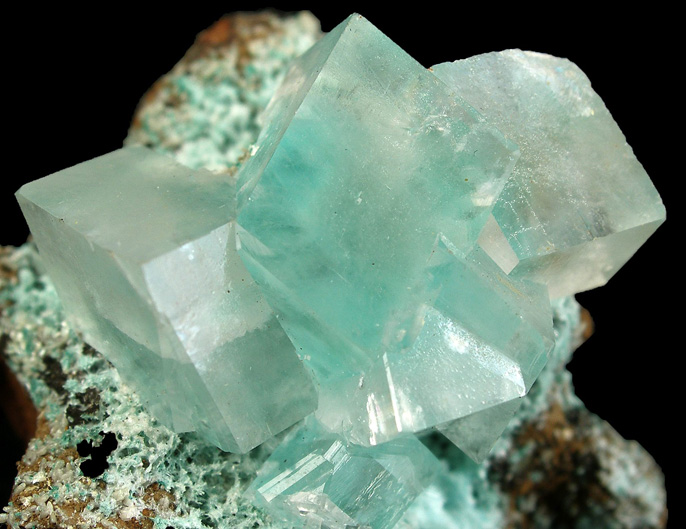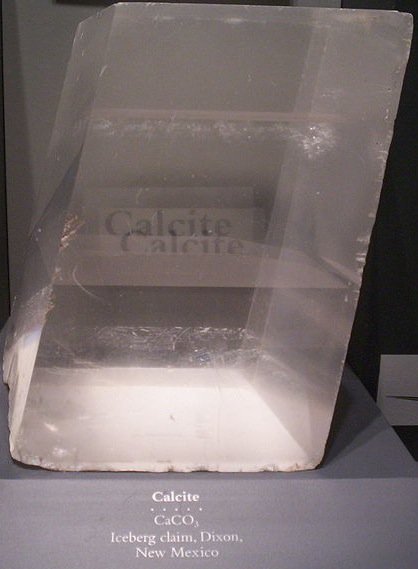Calcite
Calcite is a crystalline form of calcium carbonate. It is an extremely common mineral that makes up around 4% of the weight of the earth's crust - and it is the most common form of calcium carbonate, which is widely distributed throughout the world.

Calcite rhombs with small amount of blue impurity from fibrous aurichalcite
Photo by Rob Lavinsky, iRocks.com - image lic. under CC-BY-SA-3.0
Calcite crystals can form many different shapes including rhombohedra, prisms, tabular forms, acicular (needles), granular, massive (a large mass of indistinguishable crystals) and more. In all there are hundreds of different forms of calcite - more than there are of any other mineral. [1] Mindat states that there are over 800 calcite forms in total; most of these being prisms with scalenohedral terminations, rhombohedra (such as the examples in the images) or combinations of the two. [2]
Pure calcite is typically colorless but calcite may be found in many shades including blue, yellow, red, green, pink and orange. As is the case with many minerals, the impurities present dictate the coloration - and calcite may contain iron, magnesium, zinc, manganese or cobalt impurities in the "calcium position" of the mineral's molecular structure. [3] Calcite is a major component of sedimentary rocks such as limestone, and of metamorphic marble.
Optical Calcite /
Iceland Spar
The largest calcite crystals ever documented came from Iceland and weighed around 250 tons. [1] This variety of calcite is called "Iceland spar" or "optical calcite". It forms rhombohedral shapes, is colorless and resembles ice. Despite the name, and somewhat amusingly, much of today's Iceland spar comes not from Iceland but from Mexico. Some of the Mexican Iceland spar displays purple or blue fluorescence under UV light and some stones will even continue to glow after the UV source has been removed. [4] The name optical calcite was coined because Iceland spar has been used in optics for centuries - for lens creation. The optical qualities of this crystal were studied by Christiaan Huygens (1629-1695), Sir Isaac Newton (1643-1727) and Sir George Stokes (1819-1903). [5] It is also a popular and affordable stone for mineral collectors.
Calcite is brittle and has a hardness of only 3 on the Mohs scale. Also it will dissolve in acid - and even vinegar will cause effervescence in calcite. [1]
Calcite has a wide range of commercial uses and the primary consumer is the construction industry, which uses great quantities of limstone and marble. Calcite is used in cement, paint, ornamental stonework and as a structural material. It is also used as a soil treatment as calcite neutralizes acidic soil. [6]
As far as gemstones are concerned - calcite is not much use to the jeweller on account of its softness, but as can be seen from the uppermost image, calcite can form attractive and interesting crystals which may be of value to crystal or mineral collectors. It is often tumbled or fashioned into spheres and egg shapes; also rough pieces of calcite can often be seen for sale as for example candle holders or lamps.
Life forms such as coral and other sea creatures make their shells from calcium carbonate. Stalactites and stalagmites in caves are also made from Calcium carbonate.
To clarify one point of possible confusion: Calcite is one of the members of what is called the Calcite group of minerals. These other minerals are not actually calcite, but are simply other mineral carbonates - with the calcium ion being replaced by another metal ion. Members of the calcite group are: Calcite (CaCO3), Otavite (CdCO3), Gaspeite ({Ni, Mg, Fe}CO3), Rhodochrosite (MnCO3), Siderite (FeCO3), Magnesite (MgCO3), Smithsonite (ZnCO3) and Sphaerocobaltite (CoCO3). [7]
Other minerals formed from calcium carbonate are aragonite and vaterite. The three minerals - calcite, aragonite and vaterite, are said to be polymorphs - meaning that they have the same chemical composition but different crystal structure. [8]

Calcite
Calcite - Sources Referenced:
[1] http://en.wikipedia.org/wiki/Calcite
[2] http://www.mindat.org/min-859.html
[3] http://www.minerals.net/mineral/carbonat/calcite/calcite.htm
[4] http://www.galleries.com/minerals/carbonat/calcite/calcite.htm
[5] http://en.wikipedia.org/wiki/Iceland_spar
[6] http://www.sdnhm.org/fieldguide/minerals/calcite.html
[7] http://www.galleries.com/minerals/carbonat/calcite.htm
[8] http://en.wikipedia.org/wiki/Polymorphism_(materials_science)
Back to the Gemstones List home page - over 160 gemstones explored!
Please feel free to link to this page - copy / paste the text below: (click to select)
Privacy Policy | Cookie Policy | GDPR | About This Site / Terms

© gemstoneslist.com


